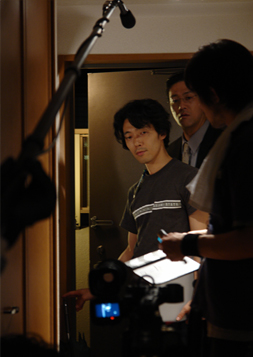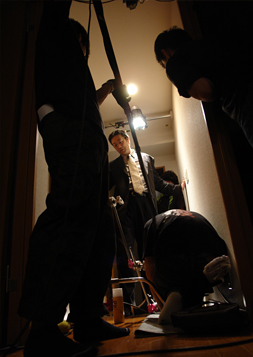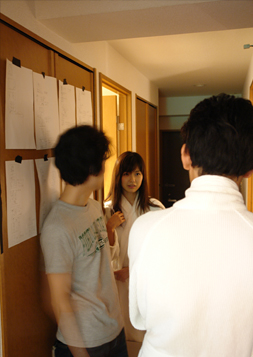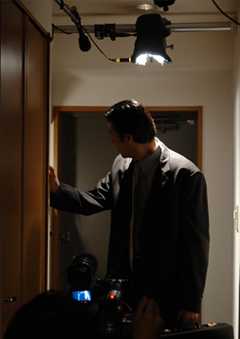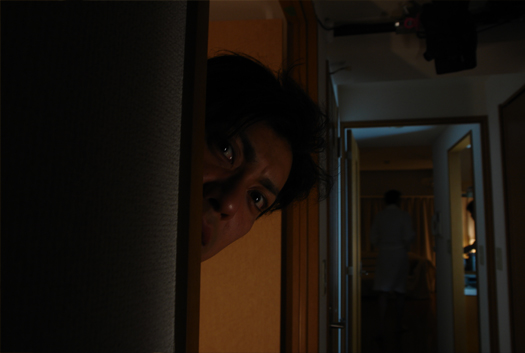
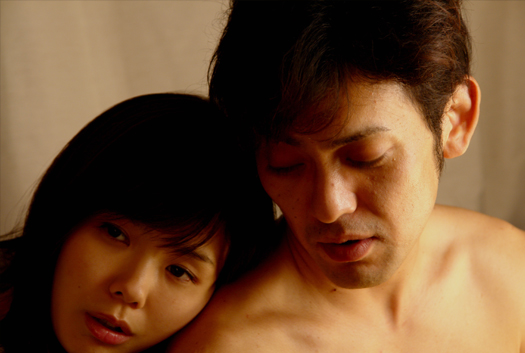
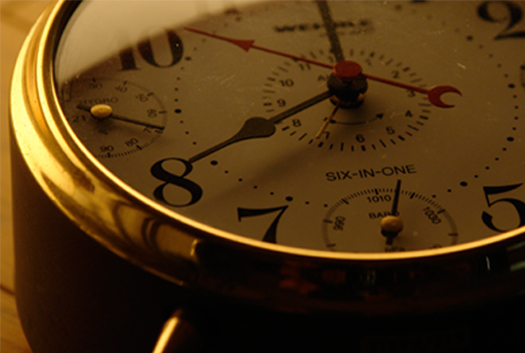

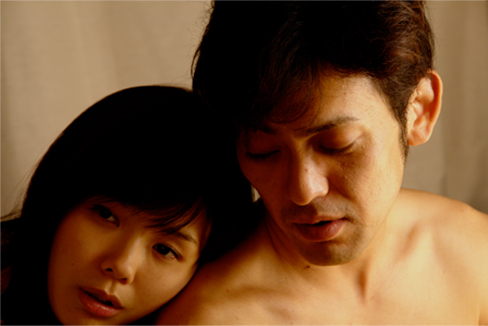
Ryoko and her husband are a Tokyo couple in a loveless marriage that is on the verge of being turned upside down. Ryoko has developed a deep resentment after years of her husband's selfish behavior and is desperate for a way out. She begins to harbor deadly designs against him.
On this particular day, Ryoko has a sudden and fiery love affair with Satoru, her best friend Aki's boyfriend. Satoru suspects he has been pulled into Ryoko's cold machinations, a plan that could wreck both of their lives.
This is a suspenseful yet humorous story about adultery and deadly conspiracy. It is a chilling and tension-filled ride. Guilty love gives way to panic and then outright conflict, followed by chaos and confusion, yet the film preserves its sense of humor all along. A common thread of true relationship weaves its way through the story, tying together the tension of the disparate scenes.
Independent Films Break
Conventional Boundaries
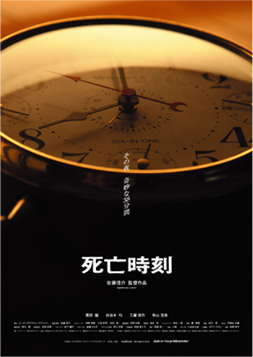
Every story needs its own length of time and has its own particular style. Time frames are fixed at less than 10 minutes for short films, perhaps longer than 80 minutes for features, and around 45 minutes for some TV programs. THE TIME OF DEATH is 40 minutes long, but it is just the right amount of time for this story to be told.
When I am writing a script I don't bind myself to the conventions of a particular genre. I enjoy a story which is unpredictable. This is why I try to free myself from the boundaries of a genre. There are pros and cons to this approach. Staying within a genre can make distribution easier, but it doesn't bring fresh new ideas.
I have been directing and screenwriting major studio works since 1996, and I am keen to make as many independent films as I can, for as long as I can. When I am planning a smaller budget independent film, I look forward to testing restrictions and doing what I cannot do in major commercial films. With indie films I also have the opportunity to work as my own producer.
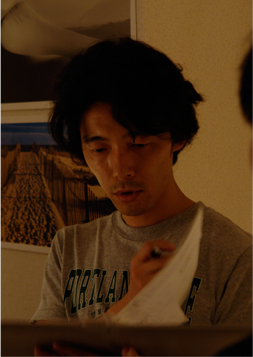
Before THE TIME OF DEATH There Was THE DEAD ANGLE
THE DEAD ANGLE is a small film I made in 2004. This part-suspense, part-mystery movie was shot on a single stage in a small room. I wrote the story in 1998, and while I had initially planned to make it in the United States, perhaps in Los Angeles, this plan never materialized.
Eventually, I moved to a brand-new apartment in Tokyo and decided I could make it there. This was a small Tokyo style apartment, only 760 square feet in size, and nothing like a big film studio, but it was handy and available.
I learned many lessons in making this film in such a small space, lessons I brought with me to THE TIME OF DEATH, which I filmed in the same location. Besides the space where it was filmed, there is little else in common between these two films.
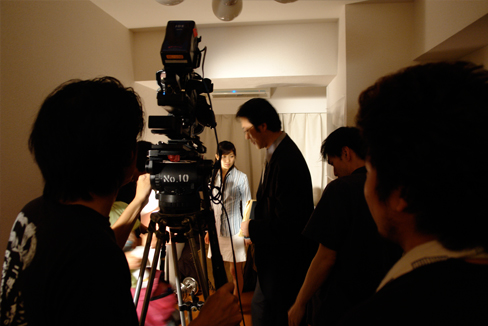
Future Prospects
For my next film, I would like to continue to use this same apartment as a stage for the story. This time, however, the setting will not be Japan, but another, less clearly defined place. While it will also be made on an independent film budget, the story is rich and suspenseful. This is still a work in progress.
THE TIME OF DEATH was made in eleven days, including four days of shooting and seven days of post-production work.
Casting And Filming
Shinsuke Sato hand-picked the actors for this production from auditions. He knew some of the actors who auditioned from prior projects, but others were completely new. All four actors chosen are talented, experienced professionals, and each one brought their own unique flair to the set.
In order to create all of the footage in four days, the cast and crew worked diligently and closely with one another. The schedule was tight but everyone was deeply engrossed in the filming process. The atmosphere became like that of a close-knit family. When he shot still life at end of the filming, some even cat-napped on Shinsuke Sato's couch!
Camera Setup
A Canon XL2 DV camera and mini35 adapter were used to create this film. The Mini35 adapter is placed between the camera and its lens. It serves to create a shallow depth of field.

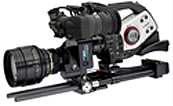
This setup provides excellent cinematic images while providing a favorable cost-to-performance ratio for independent features. This camera setup is superseded today by the Canon 5D Mk II. The XL2 5 setup with the mini35 adapter is comparable to the newer Canon 5D Mk II's image quality.
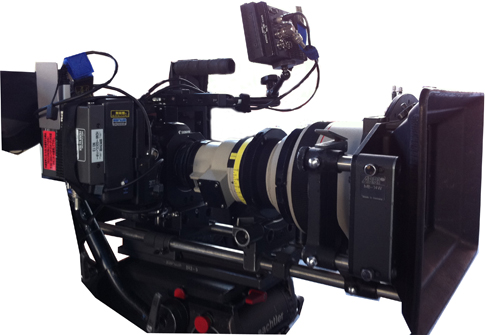
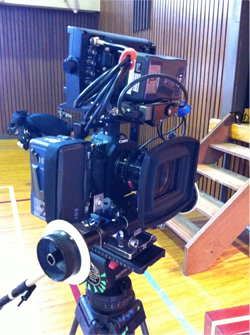
Actual shooting setup with the Canon 5D camera and lens attachment with other accessories.
Overcoming Space Limitations
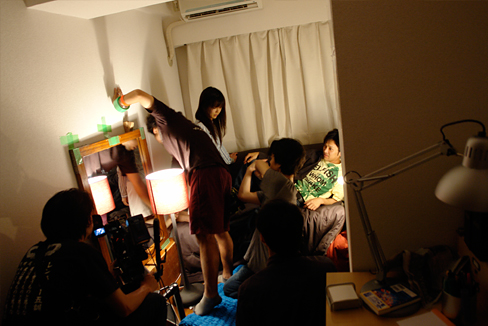
Setting up camera positions and lighting was an involved process because of the small set's space limitations. Despite these limitations, techniques were used to create spaces and dimensions like those seen in a larger set.
Mirrors were used extensively to create the right camera angle. For certain specific angles, shooting the actor's reflection in a mirror was an effective solution. After filming was completed, CG was used to flip the images. In a larger studio, these angles would typically be created by removing a wall panel and filming from that perspective.
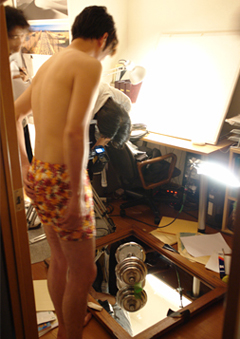
This concept was also used to create a perspective from the floor. Studios typically use removable floor panels combined with supports that elevate the floor more than a meter. For THE TIME OF DEATH, mirrors on the floor were used to create this perspective. Having the perfect camera position became all the more important. While this technique makes the use of a wide lens more challenging, the shots in this film are flawless.
The passageway in the apartment is incredibly narrow and small but it is also a setting for much of the film's action. At all costs, Shinsuke Sato wanted the perfect lighting for this film, yet the narrow space made it impossible to remove the lighting equipment out of the frame without compromising the results. Ultimately, all of the lighting equipment was left in place and deleted later by CG.
Computer Graphics
The use of CG in THE TIME OF DEATH is subtle but crucial. CG was used to quietly emphasize certain images. Motion was created by a moving CG-generated shadow. A metallic shine was added to emphasize the presence of a key object. Rather than using specific staff to physically handle moving or flying objects, CG was used. Shinsuke Sato used these CG effects to help mold the tense atmosphere of THE TIME OF DEATH.
Post Production
The film was to be shown for the first time in just seven days after the completion of filming. All of the post-production work was done by Shinsuke Sato and an assistant in these seven days.
Budget
THE TIME OF DEATH final production cost was $25,000. Originally, the film had a budget of $15,000 but real costs quickly surpassed this figure. Shinsuke Sato was able to rely on many of his friends and industry connections in making this film. Had he not done so, the production costs may likely have totalled nearer to $35,000.
Shinsuke Sato
Born in Hiroshima, Japan in 1970. Shinsuke Sato is a new director in the center of the media limelight in Japan today. He first came to attention by winning Japan's most prestigious film festival, the Pia Film Festival, as a film student.
He has worked on 25 major films as a director and screenwriter in Japan since 1996. His recent hit, GANTZ series earned $75 million domestically in Japan and was extremely well-received internationally. It was shown in more than 300 theaters nationwide in the United States in 2011.
His diverse means of expression encompasses many genres. In his Sci-Fi Action movies, his style of filmmaking and unique perspectives bring a sense of fear and danger that feel palpable and real. He brought this talent fully to bear in GANTZ in showing otherworldly, massive creatures.
The fantasy animation Oblivion Island: Haruka and the Magic Mirror won the award for Excellent Animation of the Year at the 33rd Japan Academy Prize in 2010 and garnered international praise. Though the theme is from traditional Japanese folk tales, he incorporates modern, cutting-edge animation. His animation techniques can be see in many of the movie scenes in video games such as Dynasty Warriors. His extensive past experience with CG and animation were brought to full force with Oblivion Island.
His film Sand Chronicles focuses on an adolescent girl's sometimes delicate, conflicted emotional state in human relationships.
Shinsuke Sato is also creating medium and short-length indie films with his friend and cinematographer Taro Kawazu. Together they created a series of five short format films which all take place in a single setting, with playful dialog reminiscent of Eric Rohmer. Their THE TIME OF DEATH is an example of a suspenseful yet humorous story about adultery and the conspiracy to kill a spouse. It is a chilling ride that is fast paced and exhilarating. This unique story is complemented by the film's nuanced lighting and inventive cinematography.
He is now eager to bring his Japanese directorial experience to the United States. He is passionate to make suspense movies in his own personal style.
Taro Kawazu
Born in Tokyo, Japan in 1969. Cinematographer Taro Kawazu first met Director Shinsuke Sato in film school. They began working together on a film for the Pia Film Festival and they have been teaming up ever since. His dynamic, nuanced lighting and inventive angles have earned him a glowing reputation in the Japanese film industry.
Kawazu's unique style and expertise is on full display in the popular Japan Sinks and in the Gantz series. His recent works include Girls, Sand Chronicles, and The Neighbor Number Thirteen. He is also highly respected for his work in commercial advertisements and music videos, such as HyakuiroMegane (Shiina Ringo), Kurumi (Mr. Children) and Forever Mine (Tatsuro Yamashita).
Urara Awata
Born in Kanagawa, Japan in 1974. Awata Urara began ballet studies at the tender age of three and went on to win many dance awards in her teenage years. In 1994, she joined a Broadway ballet company. She went on to acting school and made her debut in The Tokyo Siblings. Awata won the 19th Fumiko Yamaji New Film Actress Award. Since then, she has flourished in TV drama and movies. Her recent works are Into the White Night, and NHK's Kurumi No Heya.
Hitoshi Kajiki
Born in Tokyo, Japan in 1970. Hitoshi Kajiki has been active in several TV dramas and movies. He is also a member of several theater companies, including Absolutely King. Kajiki's recent works include Sand Chronicles and Heaven's story.
Shunsaku Kudo
Born in Hiroshima, Japan in 1960. Shunsaku Kudo studied with the famous actor Bunta Sugawara from 1982 to 1987. He joined the critically acclaimed theater group Karagumi in 1998. He studied further with actor and director Juro Kara. Forming the band Crossbones, Shinsaku serves as their lead singer. He is skilled in tate, the art of Japanese sword fighting. He was cast in Inception (U.S.) , On the Mountain of Tai Hang (China) , My Mother (China),The Unbroken, Unfair: The Movie, White Out, TBS's RONDO, Fuji TV's Tokyo DOGS, TV Asahi's One Missed Call and NHK's Mori Motonari.
Miki Akiyama
Born in Aichi, Japan in 1977. Miki Akiyama set out on her own and moved to Tokyo during her high school years to become an artist. She immediately began her career as a singer and an actress. She was cast in AOGRA, Go!, Cat Taxi, Fuji TV's DAYS, Arranged Marriage, and NTV's Watermelon. Akiyama also played in a number of theater productions including Agatha Christie's Poirot: Black Coffee, and Let's go home! She has performed in several music videos, including Hero (Funky Monkey Babys) and Setsuna (Greeeen).
- Directed by
- Shinsuke Sato
- Screenplay by
- Shinsuke Sato
- Produced by
- Hirotaka Asano
- Minoru Ota
- Koji Komura
- Casting Coordinated by
- Ittoku Okamoto
- Cinematography by
- Taro Kawazu
- Original Music by
- Masako Makino
- Naoko Koyama
- Editing by
- Shinsuke Sato
- Hisaki Mikimoto
- Special Effects by
- Koume
- Sound Department
- Jun Shirakawa ….. Boom Operator, Sound Mixer
- Camera and Electrical Department
- Satoru Tanaka ......Assistant Camera
- Tomoori Ugatani ...Gaffer
- Production Department
- Susumu Ikemoto....Assistant director
- Kouki Yoshida........Assistant director
- Art Department
- Rie Cho.................Art Director
- Nanako Hyodo......Costume Designer
- Tomoko Watanabe..Costumer
- Haruna Hayakawa...Costumer
- Yoko Matsushita...Hairstylist, Makeup Artist
- Still Photograph by
- Ittoku Okamoto
- Public Relation
- Rieko Watanabe
About THE TIME OF DEATH
PR:timeofdeath<at>anglepic.com ※When you send us an email, please change "<at>" into "@".
Any offers for SHINSUKE SATO
Management Office ORIGAMIX PARTNERS:contact<at>origamix.co.jp ※When you send us an email, please change "<at>" into "@".


